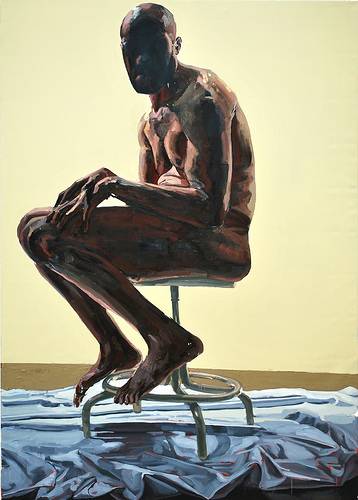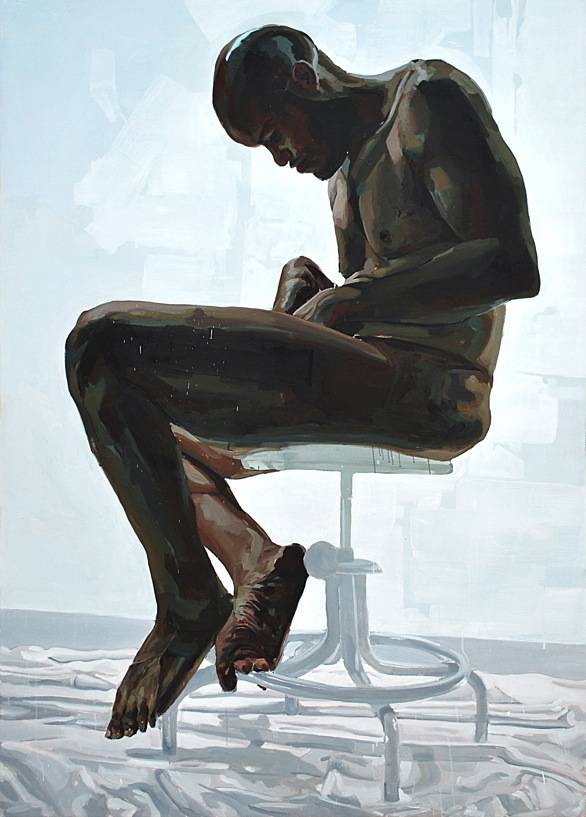Patrick Earl Hammie: Recent Works | Monday, June 28 – Thursday, August 5
Reception: Thursday, July 8, 6-8 p.m., with Gallery Talk at 7 p.m.
I decided to check out Patrick Earl Hammie’s art exhibit, “Recent Works” this past weekend at Parkland College. Before attending, I did a bit of research to find out what he’s all about. For one, he’s an African American painter that focuses on ideas surrounding race, identity, and gender politics. Also, he’s an assistant professor at the University of Illinois. In short, I was sold, and jumped on the next bus heading into the thick of Champaign.
The exhibit was located across from the student lounge, and consisted of two rooms. Each room held two types of paintings, large oil paintings on canvas, usually one per wall, and smaller oil paintings located in between the larger paintings. I headed into the room farthest from the entrance and was immediately drawn into a painting entitled, “Recognition.
 The painting depicted an African American male (presumably Hammie) sitting slouched and nude on a stool. His hands lay tensed on his knees, as he glared mercilessly from a face almost completely in shadow. The cloth beneath the stool was rumpled to look like waves, while the background was a creamy yellow. My first reaction was that of shock, but looking deeper, I noticed the subtle expressions of self-loathing and confusion portrayed in the piece. The man in the painting was not only staring at me, but also into a mirror of sorts. It was as if he was recently birthed into a physical body, and felt confused, even terrified at his condition. To me, it represented a primal, almost animalistic fear and ignorance of our own physical bodies, and found its fierce nature to be the perfect introduction to the exhibit.
The painting depicted an African American male (presumably Hammie) sitting slouched and nude on a stool. His hands lay tensed on his knees, as he glared mercilessly from a face almost completely in shadow. The cloth beneath the stool was rumpled to look like waves, while the background was a creamy yellow. My first reaction was that of shock, but looking deeper, I noticed the subtle expressions of self-loathing and confusion portrayed in the piece. The man in the painting was not only staring at me, but also into a mirror of sorts. It was as if he was recently birthed into a physical body, and felt confused, even terrified at his condition. To me, it represented a primal, almost animalistic fear and ignorance of our own physical bodies, and found its fierce nature to be the perfect introduction to the exhibit.
Wandering around the gallery, another painting stuck out and caught my attention. It was one of the smaller oil paintings, and was entitled “Platform 2”. This painting was far more simplistic, but no less powerful than “Recognition. ” It pictured the same nude male as before perched on a small platform analogous to a bird swing. He was crouched low over the platform, gazing into the piercing white that surrounds him, while timidly, curiously reaching a hand into the emptiness as if drawing water from a well. While the piece continued to explore the condition of being a physical body, I felt this painting operated on a deeper, more inward level. The endless white surrounding the man seemed to express the ideas of death and eternity simultaneously. To elaborate on these themes, the man dipping his hand into this abyss evoked feelings of fearful fascination for the inevitable as well as the recognition of self-impermanence.
Near the door where I entered, my eyes fell across a painting that tied my experience at the exhibit together beautifully. The painting was entitled “Turn” and depicted the nude male used in the other paintings sitting on a stool and gazing into his lap. His hands are lost between his thighs and it can be inferred that he is inspecting his genitals. The expression on his face is one of playful curiosity as well as concern. The background and cloth beneath the stool are comprised of soft shades of gray, giving the painting a warm yet exposed undertone. This was one of the few paintings in the exhibit that seemed to consciously separate the emotional experience of the male subject from that of the viewer. The experience of the male was almost autosexual in nature. It did not seem as if the man was consciously arousing himself as much as he was simply interested in the feelings associated with self-stimulation.

The feelings I experienced from watching this act were ones of embarrassment and discomfort. I felt that this moment was meant to be private, and I was viewing out of voyeuristic lure. The title of the painting (“Turn”) alluded to this very idea — that as a viewer, I was meant to feel uncomfortable, to remove myself, or to turn away from the moment that was being expressed entirely.
After spending a good hour or so perusing the gallery, I decided it was time to leave. I thanked the woman monitoring the exhibit, and headed home. On the whole, I felt the gallery held immense power, and communicated on a level of physicality relatable to all races, genders, and ethnicities. The sheer range of emotions evoked throughout my experience really broadened my understanding of what it is to exist within a physical form, and forced me to question how I express myself through the use of my body rather than through the use of thought. Furthering and concluding with this idea, I feel words only captured a fraction of my understanding of this gallery as so many of the paintings (including the many not directly analyzed) need and deserve a first-hand look.








